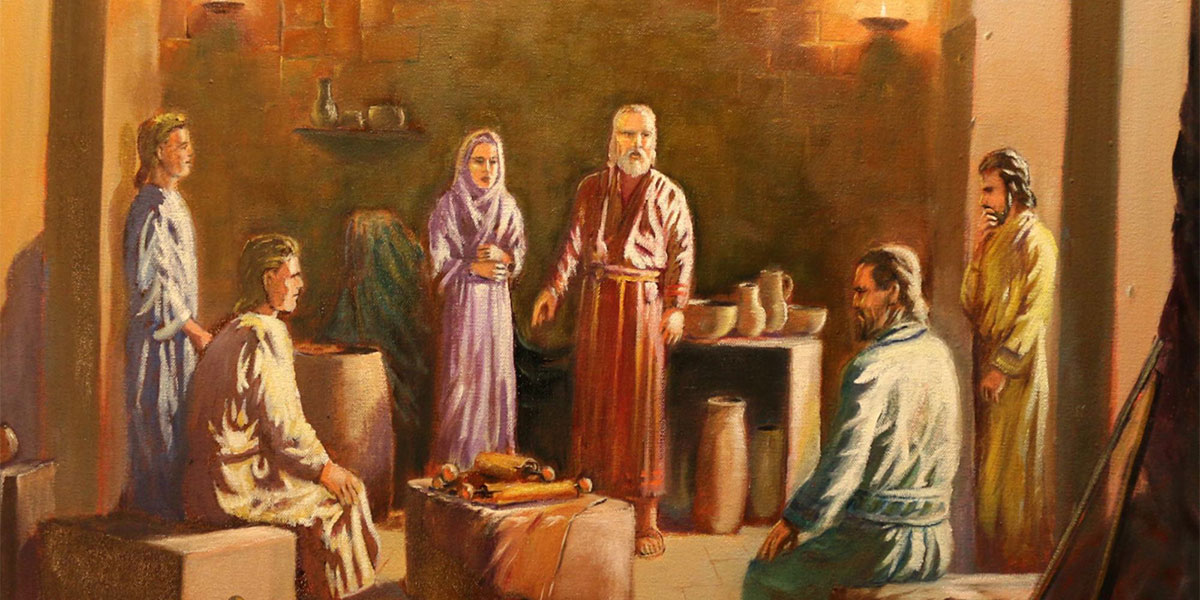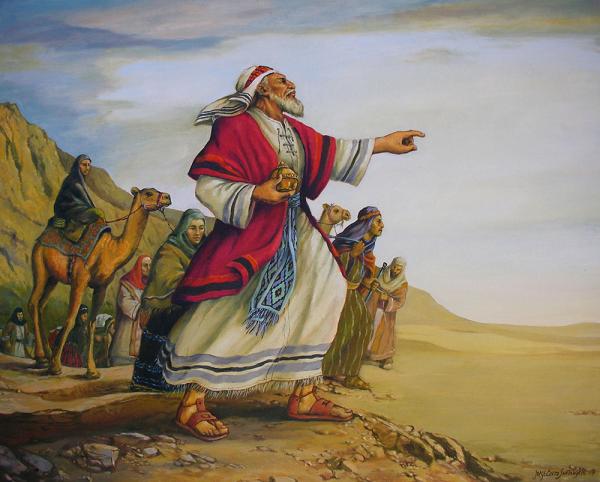You are here
When Did Lehi Leave Jerusalem?

1 Nephi 10:4
The Know
The modern chapter heading of 1 Nephi 1 indicates that the opening events began “about 600 BC.” For hundreds of years, the Nephites measured time by how long it had been since Lehi left Jerusalem.1 Knowing exactly when Lehi left would go a long way in figuring out the timing of many other Book of Mormon events.
Is it possible to be more specific about the when Lehi left Jerusalem? Scholars have used the information in the Book of Mormon to suggest a few different possibilities.
597–596 BC
Lehi began his ministry “in the commencement of the first year of the reign of Zedekiah” (1 Nephi 1:4).2 The Bible reports that King Nebuchadnezzar appointed Zedekiah as king of Judah, after Nebuchadnezzar took the city of Jerusalem and deposed Jehoiachin (2 Kings 24:9–17; 2 Chronicles 36:9–10; Jeremiah 37:1). Records reporting the activities of Babylonian kings provide the very day Nebuchadnezzar took Jerusalem: March 10, 597 BC.3 This leads many Book of Mormon scholars to conclude that Lehi left around 597–596 BC, within the first year of Zedekiah’s reign (cf. 3 Nephi, headnote).4
588–587 BC
After returning for Ishmael’s family, Nephi mentioned the prophet Jeremiah being “cast into prison” (1 Nephi 7:14). It wasn’t until toward the end of Zedekiah’s reign that Jeremiah was imprisoned, about 588–587 BC (Jeremiah 32–33; 37–38).5 Because of this, some Book of Mormon scholars think Lehi stayed in Jerusalem through most of Zedekiah’s reign and departed closer to 588–587 BC.6 Others, however, point out that there were other times Jeremiah was imprisoned.7
605 BC
Shortly after Nephi and his brothers returned, Lehi prophesied that in “six hundred years from the time [he] left Jerusalem, a prophet would the Lord God raise up among the Jews—even a Messiah, or, in other words, a Savior of the world” (1 Nephi 10:4; 19:8; 2 Nephi 25:19). Since Christ was born around 5 BC,8 there’s obviously less than 600 years between either 597 or 588 BC.
This problem led Jeffrey R. Chadwick to argue that Lehi departed in late 605 BC. He proposed that in 609 BC, when the Egyptians killed Jehoahaz and appointed Eliakim as king, the “people of the land” did not recognize the Egyptian vassal as the legitimate king, but instead considered young Zedekiah as the rightful heir. If this is true, the first year of Zedekiah’s reign mentioned by Nephi could be 608 BC, and Lehi could have left at 605 BC, a full 600 years before the birth of Christ.9
Different “Years”
Others have suggested that the Nephites counted their years differently from the traditional solar (365-day) year. For example, the Maya had two different “years”: the 365-day haab, and the 360-day tun.10 John L. Sorenson pointed out, “If we mark off 600 tun years from Zedekiah’s first year, 597–596 BC … [it] brings us into the year overlapping 5–4 BC, an acceptable date for Christ’s birth.”11
Ancient Israelites, on the other hand, used a lunar calendar of approximately 354 days, with an extra month added once every 2–3 years to keep it in sync with the solar year.12 Randall Spackman noted, if the Nephites did not add the extra month—like the “Muslim year” still used today in much of the Middle-East—then “600 strict lunar years” would pass between 588 BC and 5 BC.13 Thus, whether Lehi left in 597 or 588 BC, there are ways, based on ancient precedent, to count off 600 years until Christ was born (3 Nephi 1:1).
The Why
It is not our purpose here to adjudicate between these various proposals, ranging between 605–588 BC, for when Lehi left Jerusalem. It is enough to know that it was “about 600 BC,” as stated in the chapter heading in latest edition of 1 Nephi 1. When dealing with ancient history, it is not surprising to have ambiguity in the chronology or timing of particular events. Chronological problems and contradictions are not unknown in many authentic ancient historical documents.14
Even Mormon seems a little uncertain about how many years had passed between when Lehi left Jerusalem and the chronologically crucial time when King Mosiah took the throne, which Mormon estimated was “in the whole, about four hundred and seventy-six years” (Mosiah 6:4). Like historians today, Mormon apparently had some uncertainty about the timing of things that happened so many centuries before.
Why then would anyone want to delve into this on-going chronological inquiry? For several reasons. It can be worthwhile to explore these different possibilities. Some proposals are stronger than others and one approach will solve certain problems better than another, but all offer possible implications about the context of the early chapters of the Book of Mormon. All of the different proposals fall within a very eventful 20-year window. Each proposed departure date creates a different social and political context for the opening chapters of the Book of Mormon, yielding a variety of insights into why the Book of Mormon begins the way it does.
For many, Lehi’s 600-year prophecy is central to the Book of Mormon. For this reason, it is useful to know whether Lehi left in 588, 597, or 605 BC. Either way, the Nephites may well have meticulously and accurately counted off 600 years between that time and Christ’s birth, depending on which ancient method of counting years they used and adopted.
But the events of 3 Nephi 1 suggest that even the Nephites experienced some confusion in knowing beforehand the exact timing of Christ’s coming, despite the fairly specific prophecies of Lehi and Samuel the Lamanite.15 When Nephi said that a Messiah would come “even six hundred years from the time that my father left Jerusalem” (1 Nephi 10:4; 19:8; 2 Nephi 25:19), was he thinking 600 years to the day? Or the month? Or just within six centuries?16
This uncertainty on the exact timing of Lehi’s departure and its relationship to the birth of Christ actually helps us to take stock of our own present situation. Thinking about the years of wondering and waiting experienced by the Nephites helps us to realize that we, likewise, live in a time in which we anticipate the prophesied coming of Christ—his second coming.
The Savior declared “that the day and hour” of his coming “knoweth no man” (Matthew 24:36; cf. Mark 13:32), a fact which has been reiterated in modern revelation (see Doctrine and Covenants 49:7; 133:11). Thus, like the faithful Nephites, we too must “watch steadfastly” for the signs of his coming (3 Nephi 1:8; cf. Matthew 25:13), and be prepared to greet him whenever that glorious time arrives.
Further Reading
Jeffrey R. Chadwick, “Dating the Departure of Lehi from Jerusalem,” BYU Studies 57, no. 2 (2018): 7–51.
David Rolph Seely, “Chronology, Book of Mormon,” in Book of Mormon Reference Companion, ed. Dennis L. Largey (Salt Lake City, UT: Deseret Book, 2003), 196–204.
S. Kent Brown and David Rolph Seely, “Jeremiah’s Imprisonment and the Date of Lehi’s Departure,” Religious Educator 2, no. 1 (2001): 15–32.
Randall P. Spackman, “The Jewish/Nephite Lunar Calendar,” Journal of Book of Mormon Studies 7 (1998): 48–59, 71.
Jay H. Huber, “Lehi’s 600-Year Prophecy and the Birth of Christ,” FARMS Preliminary Report (1982).
- 1. See 2 Nephi 5:28, 34; Jacob 1:1; Enos 1:25; Jarom 1:5, 13; Omni 1:3, 5; Mosiah 6:4; 29:46; 3 Nephi 1:1; 2:6.
- 2. It’s possible that the original text of the Book of Mormon simply read “in the commencement of the reign of Zedekiah,” without “first year of the.” In the Printer’s Manuscript (the Original is not available here), “first year of the” is inserted above the line. See Royal Skousen and Robin Scott Jensen, eds., Printer’s Manuscript of the Book of Mormon, 1 Nephi 1–Alma 35, Revelations and Translations, vol. 3, part 1, The Joseph Smith Papers (Salt Lake City, UT: Church Historians Press, 2015), 21. Royal Skousen, Analysis of Textual Variants of the Book of Mormon, 6 parts, 2nd ed., Book of Mormon Critical Text Project, vol. 4 (Provo, UT: FARMS and BYU Studies, 2017), 1:59 considers this just a copyist error, but it’s possible “first year of the” was not in the original text. While this seems like an insignificant difference, based on how ancient Israelites likely counted regnal years, the commencement of the reign of a king and the commencement of the first year of the reign of a king could indeed refer to different time-periods. See Neal Rappleye, “Jerusalem Chronicle (ABC 5/BM 21946),” Nephite History in Context 1 (November 2017): 1–5, esp. n.19 for a detailed explanation.
- 3. See Jack Finegan, Handbook of Biblical Chronology, rev. ed. (Peabody, MA: Hendrickson Publishers, 1998), 256 §437. Finegan gives the date at March 16, but this is based on the Julian calendar. March 10 is the corrected date based on the Gregorian calendar we currently use. See Rappleye, “Jerusalem Chronicle (ABC 5/BM 21946),” 1–5, esp. n.15.
- 4. See Jay H. Huber, “Lehi’s 600-Year Prophecy and the Birth of Christ,” FARMS Preliminary Report (1982): 22; Robert F. Smith, “Book of Mormon Event Structure: The Ancient Near East,” Journal of Book of Mormon Studies 5, no. 2 (1996): 98–101, 122–123; David Rolph Seely, “Chronology, Book of Mormon,” in Book of Mormon Reference Companion, ed. Dennis L. Largey (Salt Lake City, UT: Deseret Book, 2003), 197–199.
- 5. Smith, “Book of Mormon Event Structure,” 125.
- 6. Randall P. Spackman, “The Jewish/Nephite Lunar Calendar,” Journal of Book of Mormon Studies 7 (1998): 48–59, 71; Randall P. Spackman, “Introduction to Book of Mormon Chronology: The Principal Prophecies, Calendars, and Dates,” FARMS Preliminary Report (1993): 6–12; Jerry D. Grover Jr., Translation of the “Caractors” Document (Provo, UT: Grover Publications, 2015), 70–73, 209–210. Brant A. Gardner, Second Witness: Analytical and Contextual Commentary on the Book of Mormon, 6 vols. (Salt Lake City, UT: Greg Kofford Books, 2007), 1:66 n.25 says that he follow’s Spackman’s chronology.
- 7. S. Kent Brown and David Rolph Seely, “Jeremiah’s Imprisonment and the Date of Lehi’s Departure,” Religious Educator 2, no. 1 (2001): 15–32; Book of Mormon Central, “How Could Nephi Have Known about Jeremiah’s Imprisonment? (1 Nephi 7:14),” KnoWhy 463 (August 30, 2018).
- 8. See Book of Mormon Central, “How Does the Book of Mormon Help Date the First Christmas? (3 Nephi 1:13),” KnoWhy 255 (December 21, 2016); Jeffrey R. Chadwick, “Dating the Birth of Jesus Christ,” BYU Studies 49, no. 4 (2010): 5–38; Lincoln H. Blumell and Thomas A. Wayment, “When Was Jesus Born? A Response to a Recent Proposal,” BYU Studies 51, no. 3 (2012): 53–81; John A. Tvedtnes, “When Was Christ Born?” Interpreter: A Journal of Mormon Scripture 10 (2014): 1–33.
- 9. Jeffrey R. Chadwick, “Dating the Departure of Lehi from Jerusalem,” BYU Studies 57, no. 2 (2018): 7–51.
- 10. For background on Mesoamerican calendrics, see Mary Miller and Karl Taube, An Illustrated Dictionary of the Gods and Symbols of Ancient Mexico (London: Thames and Hudson, 1993), 48–54; Janine Gasco, “Calendrics,” in Archaeology of Ancient Mexico and Central America: An Encyclopedia (New York: Routledge, 2001), 90–92; John S. Justeson and Terrence Kaufman, “Calendars and Calendrical Systems: Mesoamerican Calendar,” in The Oxford Encyclopedia of Mesoamerican Cultures: The Civilizations of Mexico and Central America, 3 vols., ed. Davíd Carrasco (New York: Oxford University Press, 2001), 1:121–24. Among the Maya, the terms tun and haab were actually interchangeable for both the 360-day and 365-day period, demonstrating that they regarded the 360-day period as a “year.” See Neal Rappleye, “‘The Time is Past’: A Note on Samuel’s Five-Year Prophecy,” Interpreter: A Journal of Mormon Scripture 29 (2018): 25–27.
- 11. John L. Sorenson, An Ancient American Setting for the Book of Mormon (Salt Lake City and Provo, UT: Deseret Book and FARMS, 1985), 273. For a full Book of Mormon chronology using the tun as the year, demonstrating that 600 tuns can be counted off using from a May 596 BC departure to a September 5 BC birth of Christ, see Robert F. Smith, ed., Book of Mormon Critical Text: A Tool for Scholarly Reference, 3 vols. (Provo, UT: FARMS, 1984–1987), 3:1321–1325.
- 12. Finegan, Handbook of Biblical Chronology, 31–32 §61.
- 13. Spackman, “Jewish/Nephite Lunar Calendar,” 57.
- 14. For example, when taken at face-value, the combined chronologies of Israel’s and Judah’s kings add up to different totals for the same time-span, and both are too long to be consistent with external dates. See Edwin R. Thiele, The Mysterious Numbers of the Hebrew Kings, new rev. ed. (Grand Rapids, MI: Kregel, 1983), 15–17, 36–37.
- 15. On this confusion, and the possibility that the use of different ancient calendars contributed to it, see Rappleye, “The Time is Past,” 21–30. Also note, Samuel’s prophecy said, “Behold, I give unto you a sign; for five years more cometh, and behold, then cometh the Son of God to redeem all those who shall believe on his name” (Helaman 14:2). Samuel’s words did not say how many months after the remaining five-year repentance time would see the coming of the Son of God.
- 16. See Tvedtnes, “When Was Christ Born?,” 15–16.
KnoWhy Citation
Related KnoWhys
Subscribe
Get the latest updates on Book of Mormon topics and research for free







